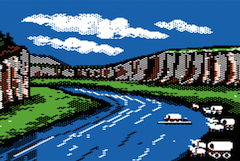Here Lies Sillypants McFartybottom: How The Oregon Trail Became The Best Part Of Learning
Bring up The Oregon Trail with anyone who had computers in school that were nowhere near flat screens and everyone will have an opinion on whether to ford a river or pay for the ferry, how much to spend on supplies, and what to name your fictional kids so as to create the funniest tombstone when he or she inevitably dies of dysentery. All in the name of education, of course.
While we all might know (or think we know) the best way to hunt for buffalo on the virtual trail, what most of us probably don’t know is how something so fun became a part of the school room experience in the first place.
Mental Floss delves deep into the origin story of Oregon Trail, bringing to light its creation at the hands of three college students who were student teachers back in 1971. One of the men was trying to figure out a way to get his eight graders into a history unit called, “The Western Expansion of the Mid-19th Century.”
He had the idea to make a board game about the Oregon Trail, to get kids involved in the process of being a pioneer, facing life and death circumstances along the way, fighting for survival. What could hit home better than that? Well, for starters, a video game could, suggested one of his pals. And that was that.
Okay so it was a bit more involved than that, considering the teletype/computer system schools had back then involved the three men sitting in a janitor’s closet (where the school’s mainframe computer resided) to get the game coded and done in two weeks.
The first iteration of Oregon Trail sounds like the equivalent of a Flintstone’s car — to hunt, kids had to type “bang” into the teletype system, and if it wasn’t done fast enough, the machine replied with “A little slow on your Colt .45.”
It caught on, and quick.
“The Oregon Trail was one of the first educational software applications that put you into the program,” says one of the creators. “Despite the lack of graphics, students who played weren’t students anymore. They were settlers crossing a wasteland. Their decisions were a question of life or death.”
From there on the game spread to other schools, and the creators kept working on and revising the code to smooth out the kinks. Kids loved it, and they were learning while also thinking up creative names for fictional family members that would guarantee a laugh when a tombstone popped up along the trail.
But after that semester, the teacher deleted the game from the area’s time-share program for schools, since he didn’t need it anymore. Years later, a former math teacher involved with a program that provided computers and training to schools in Minnesota hired Oregon Trail’s co-creator for a job. He pulled out his old code for the game and began working on it all over again.
After discussing it with his old cohorts, the teacher improved the game and added new details, debuting a fresh version of the game to the school system in Minnesota. As Apple II computers spread to Minnesota’s schools in the late seventies, The Oregon Trail came along with them, and that was that. The game was in almost 5,000 school districts nationwide, beaming into the eyeballs and brains of school kids forevermore.
It’s a lot more involved than that, so check out Mental Floss’ in-depth history of the game in the source link below. And just feel yourself longing to be back out on that pixelated trail again…
The Legend of The Oregon Trail [Mental Floss]
Want more consumer news? Visit our parent organization, Consumer Reports, for the latest on scams, recalls, and other consumer issues.


